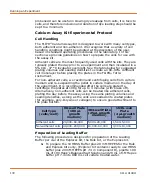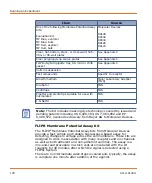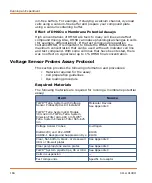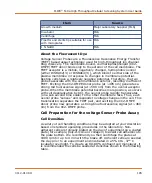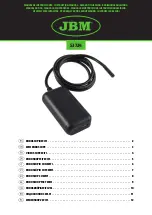
FLIPR
®
Tetra High Throughput Cellular Screening System User Guide
0112-0109 H
185
About the Fluorescent Dye
Voltage Sensor Probes are a Fluorescence Resonance Energy Transfer
(FRET) based assay technology used for high-throughput ion channel
drug discovery. The membrane-bound, coumarinphospholipid (CC2-
DMPE) FRET donor binds only to the exterior of the cell membrane. The
FRET acceptor is a mobile, negatively charged, hydrophobic oxonol
[either DiSBAC2(3) or DiSBAC4(3)], which binds to either side of the
plasma membrane in response to changes in membrane potential.
Resting cells have a relatively negative potential. Therefore, the two
probes associate with the cell membrane exterior, resulting in efficient
FRET. Exciting the CC2-DMPE donor probe (at ~405 nm) generates a
strong red fluorescence signal (at ~580 nm) from the oxonol acceptor
probe. When the membrane potential becomes more positive, as occurs
with cell depolarization by KCl, the oxonol probe rapidly translocates
(on a sub second time scale) to the other membrane face. Thus, each
oxonol probe "senses" and responds to voltage changes in the cell. This
translocation separates the FRET pair, and exciting the CC2-DMPE
donor probe now generates a strong blue fluorescence signal (at ~460
nm) from the CC2-DMPE probe.
Cell Preparation for the voltage Sensor Probe Assay
Cell Densities
A variety of cell handling conditions may be adopted at your discretion
based on standard operating procedures in the laboratory. Non-
adherent cells are typically plated on the day of experiment on a coated
plate (for example
,
poly-d-lysine or collagen) to assist cell adherence to
the plate bottom. We recommend you then centrifuge the plates at
1000 rpm for up to 4 min with the brake off. Adherent cells are seeded
the day prior to an experiment and incubated in a 5% CO
2
, 37° C
incubator overnight. To create an 80–90% confluent cell monolayer, it
is recommended the cells be seeded at densities shown in the following
table.
Growth medium
Major Laboratory Supplier (MLS)
Incubator MLS
Centrifuge
MLS
Pipettor and sterile tips suitable for use
with microplates
MLS
1 N NaOH
MLS
Item
Source
Summary of Contents for FLIPR Tetra
Page 1: ...FLIPR Tetra High Throughput Cellular Screening System User Guide 0112 0109 H December 2011...
Page 12: ...Contents 12 0112 0109 H...
Page 16: ...System Overview 16 0112 0109 H...
Page 40: ...System Hardware Features 40 0112 0109 H...
Page 148: ...Exchanging Hardware 148 0112 0109 H...
Page 156: ...Calibration and Signal Test 156 0112 0109 H...
Page 196: ...Running an Experiment 196 0112 0109 H...
Page 232: ...Robotic Integration 232 0112 0109 H The following drawings illustrate these requirements...
Page 282: ...Data Processing Algorithms 282 0112 0109 H...
Page 294: ...Consumables and Accessories 294 0112 0109 H...
Page 298: ...Using AquaMax Sterilant 298 0112 0109 H...
Page 302: ...Electromagnetic Compatibility EMC 302 0112 0109 H...


